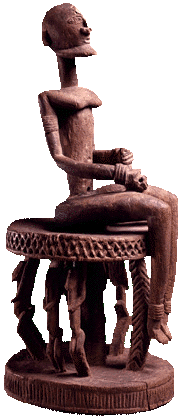
SAHEL AND SAVANNA

SAHEL AND SAVANNA
 Seated Figure
Seated Figure
Dogon, Mali, 19th-20th Century, Wood, Private Collection
Between the Sahara desert and the rain forests near the western African coast lie the Sahel and the Savanna. The term sahel is Arabic for "shore"-it is the southern boundary of the Sahara desert, which was likened to a sea. The term savanna refers to a tr
eeless or sparsely forested plain. However, the desert was not an impermeable barrier. A number of trade routes crossed it from early times, giving impetus to many empires, including those of ancient Ghana, medieval Mali, and Songhai.
Beginning in the seventh century, traders from the north brought Islam and literacy, which had great impact on traditional beliefs and paved the way for jihads (holy wars) across much of the Savanna. By the nineteenth century, these wars reached deep into
western Africa.
Islam also brought with it architectural innovations, including an array of house and mosque types. In addition, textile patterns, the horizontal loom (used primarily by men), and clothing styles in this region echo northern prototypes.
Mask , Bamana, Wood and cowries, Collection of Marc and Denyse GinzbergThe Niger River flows from west to east through much of the area, turning south through Nigeria to empty by way of a large delta into the Gulf of Guinea. In Mali, the river separates into a number of streams that later reunite in an area called the inland delta. Here, an early civilization flourished, named Djenne after a nearby city renowned as a center of commerce and learning. A host of brilliant terra-cottas and metal sculptures known from this area have for the most part been illicitly excavated and are consequently not included in this exhibition.
The inland delta is also the homeland of various cultures that resisted Islamic proselytizing, such as the Bamana and Dogon (of Mali), the Mossi and Gurunsi (in what is today Burkina Faso), and the Lobi and Moba (in areas bordering on western Africa).
Masks and figures associated with initiation and funerary practices are widespread among these groups, although the impact of both Islam and Christianity has been felt.Throughout the region, artists are members of special groups. Often referred to as "castes," these are perhaps more like guilds of artisans. The specialists associated with these guilds include blacksmiths (whose wives are potters), leatherworkers, and ba rds.
<- Back to the Main Index Page
<- To the Clickable Map of Africa ->
<-To Programs and Events in Conjunction with this Exhibition ->